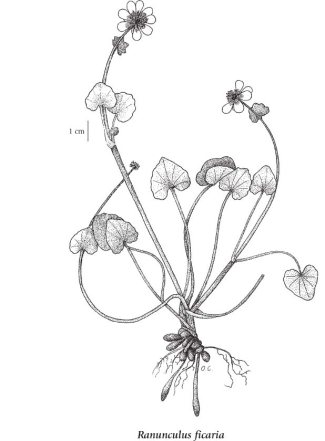Click on the image below to view an
expanded illustration for this species.

|
General:
Perennial herb from club-shaped tubers and fibrous roots; stems 1 to several, soft, decumbent and rooting at nodes, or ascending to erect, sometimes producing axillary bulblets, smooth.
Leaves:
Basal leaves simple, undivided, kidney- or heart-shaped to triangular, 1.8-3.7 cm long, 2-4 cm wide, round-toothed or entire, bases broadly heart-based, tips rounded or blunt, long-stalked, the stalks with dilated, sheathing bases; stem leaves similar, alternate, short-stalked, the upper sometimes nearly opposite.
Flowers:
Inflorescence of solitary, terminal flowers on each major branch, the flowers 2-3 cm wide; long-stalked; receptacle smooth; petals 8 to 12, distinct, bright yellow, fading whitish, 10-15 mm long, 3-7 mm wide, nectary on upper surface, the scale smooth, 2-toothed; sepals 3, spreading, early deciduous, green, 4-9 mm long, 3-6 mm wide, smooth, sac-shaped at base; stamens 15-30; pistils 15-30.
Fruits:
Achenes, several to many in a globe-shaped head 4-5 mm long, 6-8 mm wide, the achenes ellipsoid, 2.6-2.8 mm long, 1.8-2 mm wide, hairy; beaks absent.
Source: The Illustrated Flora of British Columbia
|